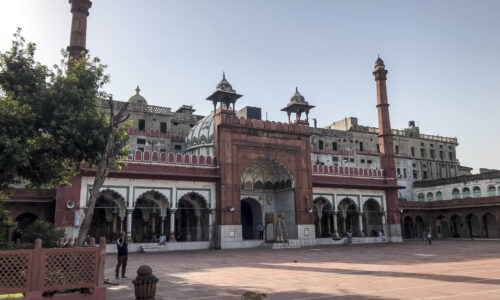
“Shah Jahan’s Shahjahanabad,” the glorious capital of the Mughal dynasty, was the brainchild of Shah Jahan. Its structures spoke of the grandeur and greatness of their patron. However, not all structures in this mid-17th century city were by the emperor. Most commercial, public, cultural, and religious spaces were based on individual enterprise, and some were even patronized by women. The architectural and cultural fabric of the city is interwoven with the stories of the women who resided and created the city as we imagine it today.
Since its inception, the royal women of the Mughal dynasty were instrumental in maintaining the strength of the empire. From behind their purdahs, these women not only influenced politics but also accumulated huge fortunes through trade, royal allowances, and titles. It was this wealth that was used to create structures to maintain the legacy of these strong female characters. Starting from the Padshah Begum of Shah Jahan himself, Jahanara Begum wielded her wealth to construct the ever-famous Chandni Chowk. This chowk was a commercial square right outside the Lahori Gate and was supplemented with a sarai, a garden, and even a stream of water which broadened to form a pool. Given the huge commercial transactions that took place in the 1560 shops (approx.) of the chowk, traders benefitted from the grand ninety-roomed sarai that she constructed to the north of the square for the prosperous traders to stay. There was a public bath, or hammam as well. However, the garden called Sahibabad (after her title Begum Sahib), presented to Jahanara by her father for upkeep, was constructed exclusively for royal or noblewomen’s use. The garden supposedly had fountains, pools, swings, and some pavilions, and it even hosted festivities like the Pankhonka Mela for the Mughal women.
The imperial city of Shahjahanabad was dotted with mosques, several of which were patronized by Mughal royal women. Akbaradi Begum, who became the chief consort of Shah Jahan after the death of Mumtaz Mahal, had built a mosque to the south of Qila – e – Moalla, or Red Fort. Another mosque, called the Fatehpuri Masjid was built by Fatehpuri Begum in 1650. This mosque is the second largest mosque in Delhi and sits at the western end of Chandni Chowk, opposite Lahori Gate. It has been recorded that Aurangabadi Begum, Aurangzeb’s wife, sponsored the construction of a mosque near the Lahori Gate. Aurangzeb’s daughter, Zeenat-ul Nissa, also extended her patronage towards the construction of a grand mosque. This was built in 1700 to the south of the fort (present-day Daryaganj) and was called Zeenat-ul Masjid, or Ghata Masjid. The extremely influential wife of Muhammad Shah and mother of Ahmad Shah, Quidsia Begum, exercised her power with the help of Javed Khan, the eunuch in charge of the royal harem. Although a dancing girl before marriage, Quidsia Begum had built several structures, along with a separate palace for herself from where she wielded her power. Even within Shahjahanabad, she left her mark of legacy by constructing a mosque near the southern gate of the fort along with Javed Khan. Known as Sunehri Masjid due to its golden metal-plated domes, this mosque from 1750 is made with buff-coloured stones, which is uncommon for the mosques of the area. Another famous mosque within the city though was not commissioned by a Mughal royal, is worth mentioning as it owes its patronage to the wife of the first ‘Resident’ of the East India Company in the Mughal court, General David Octerlony. General Octerlony had married a nautch girl, Mubarak Begum, who wielded a lot of influence and thus built the Masjid Mubarak Begum. The masses, however, did not forget her past, and to date continue to call this mosque Randi ki Masjid (the ‘prostitute’s mosque’).
While there are several houses and havelis at Shahjahanabad, it is unusual to find one belonging to a Mughal Empress, Zinat Mahal’s Haveli breaks the norm. Zinat Mahal, the wife of the last Mughal emperor Bahadur Shah Zafar, was extremely ambitious and influential. She went to great lengths to secure her and her son’s future. It is said that she even poisoned the then-British Resident Thomas Metclafe for siding with Mirza Fakhru, the emperor’s eldest son. Her haveli, like her life, is in a tragic, dilapidated state. Built in 1846 in the Lal Kuan locality, it is said that the choice of location was strategic; to establish herself in the city for survival even after her husband’s death. Unfortunately, fate had different plans.

The Revolt of 1857 changed the landscape of Shahjahanabad. While some properties of the royal family were confiscated, others were demolished. Demolitions occurred within the fort to build barracks for the army, as well as around it for security reasons. Jahanara Begum’s Chandni Chowk wasn’t the way we perceive it today. It has been demolished and transformed significantly since the Revolt. A colonial-era town hall can be found in place of the sarai, while Bagh Shibabad was cleared to make way for the railway line. Although Akbarabadi Begum’s masjid fell due to the clearance drive around the fort, the Fatehpuri Masjid miraculously managed to survive despite being the hotbed of Indian soldiers in the Revolt. The Sunehri Masjid and haveli of Zeenat Mahal have managed to survive, but they miss their original grandeur.
Although mostly in ruins, these structures of Shahjahanabad help us understand the agency of royal Mughal women. The ideology employed by almost all women sponsoring construction activities was to ensure their legacy and economic rights. Apart from being great markers of wealth and influence, women could also hold rights over the immobile properties sponsored by them. This gave a major impetus to the construction activities in Shahjahanabad.




